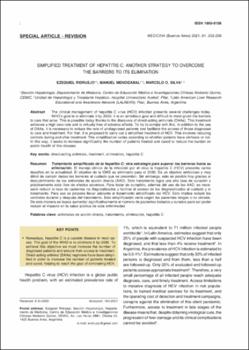Simplified treatment of hepatitis C: another strategy to overcome the barriers to its elimination

View/
Date
2021-01Author
Mendizabal, Manuel.
Silva, Marcelo.
Ridruejo, Ezequiel.
Metadata
Show full item recordAbstract
Abstract in English, Spanish
The clinical management of hepatitis C virus (HCV) infection presents several challenges today. WHO's goal is to eliminate it by 2030. It is an ambitious goal and difficult to meet given the barriers to care that arise. This is possible today thanks to the discovery of direct-acting antivirals (DAAs). This treatment achieves a high cure rate and is virtually free of adverse effects. To try to comply with this, in addition to the use of DAAs, it is necessary to reduce the rate of undiagnosed patients and facilitate the access of those diagnosed to care and treatment. For that, it is proposed to carry out a simplified treatment of HCV. This involves reducing controls during and after treatment. This simplification varies according to whether patients have cirrhosis or not. In this way, it seeks to increase significantly the number of patients treated and cured to reduce the burden on public health of this disease.
Keywords: direct-acting antivirals; elimination; hepatitis C; treatment.
Collections
The following license files are associated with this item:

